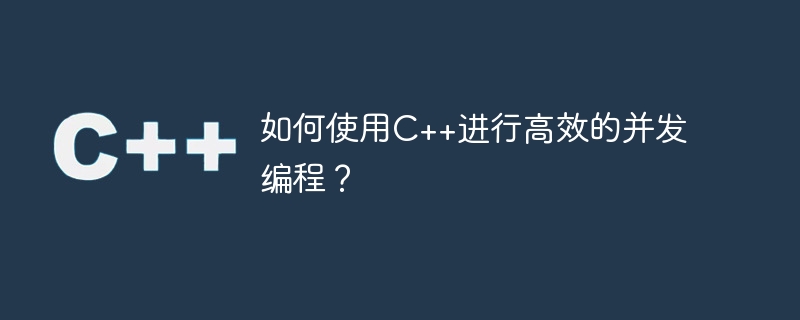如何使用C++进行高效的并发编程?

如何使用C++进行高效的并发编程?
引言:
随着计算机系统的发展,多核技术的普及,以及对高并发处理需求的增加, 并发编程变得越来越重要。C++ 是一门强大的编程语言,具备丰富的并发编程工具和库。本文将介绍如何使用 C++ 进行高效的并发编程,并提供一些示例代码。
一、线程与线程管理:
- 创建线程:
C++ 11 引入了<thread></thread>头文件,通过std::thread类可以轻松创建新线程。以下是创建线程的示例代码:<thread></thread>头文件,通过std::thread类可以轻松创建新线程。以下是创建线程的示例代码:
#include <iostream>
#include <thread>
void myFunction() {
std::cout << "This is a new thread." << std::endl;
}
int main() {
std::thread t(myFunction); // 创建一个新线程
t.join(); // 主线程等待新线程执行完毕
return 0;
}- 线程管理:
std::thread类的实例可以join()或detach(),当调用join()时,主线程将等待该线程执行完毕,而detach()则会让新线程在后台运行。以下是线程管理的示例代码:
#include <iostream>
#include <thread>
void myFunction() {
std::cout << "This is a new thread." << std::endl;
}
int main() {
std::thread t(myFunction); // 创建一个新线程
t.detach(); // 将线程设置为后台运行
// 主线程可以继续执行其他任务
return 0;
}二、互斥锁和条件变量:
- 互斥锁:
互斥锁(Mutex)用于保护共享资源,避免多个线程同时对资源进行访问而导致冲突。以下是互斥锁的示例代码:
#include <iostream>
#include <thread>
#include <mutex>
std::mutex mtx; // 创建互斥锁
void myFunction() {
mtx.lock(); // 加锁
std::cout << "This is a critical section." << std::endl;
mtx.unlock(); // 解锁
}
int main() {
std::thread t1(myFunction);
std::thread t2(myFunction);
t1.join();
t2.join();
return 0;
}- 条件变量:
条件变量(Condition Variable)用于线程间的同步,可以阻塞一个线程,直到其他线程满足某个条件才唤醒它。以下是条件变量的示例代码:
#include <iostream>
#include <thread>
#include <mutex>
#include <condition_variable>
std::mutex mtx; // 创建互斥锁
std::condition_variable cv; // 创建条件变量
bool ready = false; // 条件
void myFunction() {
std::unique_lock<std::mutex> ul(mtx);
cv.wait(ul, []{ return ready; }); // 阻塞线程直到满足条件
std::cout << "This is a new thread." << std::endl;
}
int main() {
std::thread t(myFunction);
{
std::lock_guard<std::mutex> lg(mtx);
ready = true;
}
cv.notify_one(); // 唤醒等待条件的线程
t.join();
return 0;
}三、并发容器:
C++ 11 引入了多个并发容器来解决多线程访问共享数据的问题,其中包括 std::vector、std::map、std::queue 等。以下是使用并发容器的示例代码:
#include <iostream>
#include <thread>
#include <vector>
std::vector<int> sharedVector; // 共享容器
std::mutex mtx; // 创建互斥锁
void producer() {
for (int i = 0; i < 10; ++i) {
std::lock_guard<std::mutex> lg(mtx);
sharedVector.push_back(i);
}
}
void consumer() {
for (int i = 0; i < 10; ++i) {
std::lock_guard<std::mutex> lg(mtx);
if (!sharedVector.empty()) {
std::cout << sharedVector.back() << std::endl;
sharedVector.pop_back();
}
}
}
int main() {
std::thread t1(producer);
std::thread t2(consumer);
t1.join();
t2.join();
return 0;
}结论:
使用 C++ 进行高效的并发编程是一项重要的技术要求。通过深入了解 C++ 的线程、互斥锁、条件变量和并发容器,我们可以更好地处理多线程编程中的数据共享和同步问题,并提高程序的性能和效率。
参考资料:
- C++ Reference -
<thread></thread>:https://www.cplusplus.com/reference/thread/ - C++ Reference -
<mutex></mutex>:https://www.cplusplus.com/reference/mutex/ - C++ Reference -
<condition_variable></condition_variable>rrreee
std::thread 类的实例可以 join() 或 detach(),当调用 join() 时,主线程将等待该线程执行完毕,而 detach() 则会让新线程在后台运行。以下是线程管理的示例代码:🎜🎜rrreee🎜二、互斥锁和条件变量:🎜🎜🎜互斥锁:🎜互斥锁(Mutex)用于保护共享资源,避免多个线程同时对资源进行访问而导致冲突。以下是互斥锁的示例代码:🎜🎜rrreee- 🎜条件变量:🎜条件变量(Condition Variable)用于线程间的同步,可以阻塞一个线程,直到其他线程满足某个条件才唤醒它。以下是条件变量的示例代码:🎜🎜rrreee🎜三、并发容器:🎜C++ 11 引入了多个并发容器来解决多线程访问共享数据的问题,其中包括
std::vector、std::map、std::queue 等。以下是使用并发容器的示例代码:🎜rrreee🎜结论:🎜使用 C++ 进行高效的并发编程是一项重要的技术要求。通过深入了解 C++ 的线程、互斥锁、条件变量和并发容器,我们可以更好地处理多线程编程中的数据共享和同步问题,并提高程序的性能和效率。🎜🎜参考资料:🎜🎜🎜C++ Reference - <thread></thread>:https://www.cplusplus.com/reference/thread/🎜🎜C++ Reference - <mutex></mutex>:https://www.cplusplus.com/reference/mutex/🎜🎜C++ Reference - <condition_variable></condition_variable>:https://www.cplusplus.com/reference/condition_variable/🎜🎜以上是如何使用C++进行高效的并发编程?的详细内容。更多信息请关注PHP中文网其他相关文章!

热AI工具

Undresser.AI Undress
人工智能驱动的应用程序,用于创建逼真的裸体照片

AI Clothes Remover
用于从照片中去除衣服的在线人工智能工具。

Undress AI Tool
免费脱衣服图片

Clothoff.io
AI脱衣机

AI Hentai Generator
免费生成ai无尽的。

热门文章

热工具

记事本++7.3.1
好用且免费的代码编辑器

SublimeText3汉化版
中文版,非常好用

禅工作室 13.0.1
功能强大的PHP集成开发环境

Dreamweaver CS6
视觉化网页开发工具

SublimeText3 Mac版
神级代码编辑软件(SublimeText3)

热门话题
 C语言数据结构:树和图的数据表示与操作
Apr 04, 2025 am 11:18 AM
C语言数据结构:树和图的数据表示与操作
Apr 04, 2025 am 11:18 AM
C语言数据结构:树和图的数据表示与操作树是一个层次结构的数据结构由节点组成,每个节点包含一个数据元素和指向其子节点的指针二叉树是一种特殊类型的树,其中每个节点最多有两个子节点数据表示structTreeNode{intdata;structTreeNode*left;structTreeNode*right;};操作创建树遍历树(先序、中序、后序)搜索树插入节点删除节点图是一个集合的数据结构,其中的元素是顶点,它们通过边连接在一起边可以是带权或无权的数据表示邻
 C语言文件操作难题的幕后真相
Apr 04, 2025 am 11:24 AM
C语言文件操作难题的幕后真相
Apr 04, 2025 am 11:24 AM
文件操作难题的真相:文件打开失败:权限不足、路径错误、文件被占用。数据写入失败:缓冲区已满、文件不可写、磁盘空间不足。其他常见问题:文件遍历缓慢、文本文件编码不正确、二进制文件读取错误。
 在C中如何有效地使用RVALUE参考?
Mar 18, 2025 pm 03:29 PM
在C中如何有效地使用RVALUE参考?
Mar 18, 2025 pm 03:29 PM
文章讨论了在C中有效使用RVALUE参考,以进行移动语义,完美的转发和资源管理,重点介绍最佳实践和性能改进。(159个字符)
 如何在C 20中使用范围进行更有表现的数据操纵?
Mar 17, 2025 pm 12:58 PM
如何在C 20中使用范围进行更有表现的数据操纵?
Mar 17, 2025 pm 12:58 PM
C 20范围通过表现力,合成性和效率增强数据操作。它们简化了复杂的转换并集成到现有代码库中,以提高性能和可维护性。
 动态调度如何在C中起作用,如何影响性能?
Mar 17, 2025 pm 01:08 PM
动态调度如何在C中起作用,如何影响性能?
Mar 17, 2025 pm 01:08 PM
本文讨论了C中的动态调度,其性能成本和优化策略。它突出了动态调度会影响性能并将其与静态调度进行比较的场景,强调性能和之间的权衡
 如何使用C中的移动语义来提高性能?
Mar 18, 2025 pm 03:27 PM
如何使用C中的移动语义来提高性能?
Mar 18, 2025 pm 03:27 PM
本文讨论了使用C中的移动语义来通过避免不必要的复制来提高性能。它涵盖了使用std :: Move的实施移动构造函数和任务运算符,并确定了关键方案和陷阱以有效
 c语言函数的基本要求有哪些
Apr 03, 2025 pm 10:06 PM
c语言函数的基本要求有哪些
Apr 03, 2025 pm 10:06 PM
C语言函数是代码模块化和程序搭建的基础。它们由声明(函数头)和定义(函数体)组成。C语言默认使用值传递参数,但也可使用地址传递修改外部变量。函数可以有返回值或无返回值,返回值类型必须与声明一致。函数命名应清晰易懂,使用驼峰或下划线命名法。遵循单一职责原则,保持函数简洁性,以提高可维护性和可读性。
 什么是自动类型扣除?它的好处和局限性是什么?
Mar 26, 2025 pm 11:23 PM
什么是自动类型扣除?它的好处和局限性是什么?
Mar 26, 2025 pm 11:23 PM
本文讨论了编程中的自动类型扣除额,详细介绍了其益处,例如降低代码的冗长和提高的可维护性以及其局限性,例如潜在的混乱和调试挑战。






